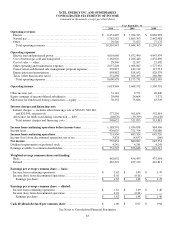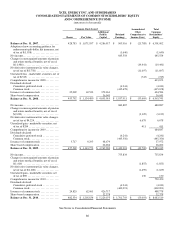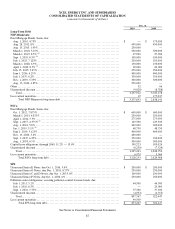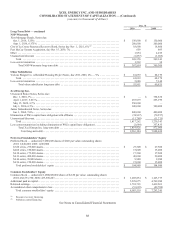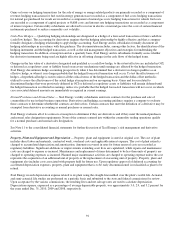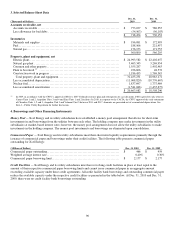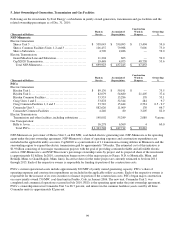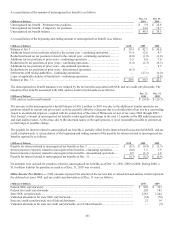Xcel Energy 2010 Annual Report Download - page 102
Download and view the complete annual report
Please find page 102 of the 2010 Xcel Energy annual report below. You can navigate through the pages in the report by either clicking on the pages listed below, or by using the keyword search tool below to find specific information within the annual report.92
AFUDC — AFUDC represents the cost of capital used to finance utility construction activity. AFUDC is computed by applying a
composite pretax rate to qualified CWIP. The amount of AFUDC capitalized as a utility construction cost is credited to other
nonoperating income (for equity capital) and interest charges (for debt capital). AFUDC amounts capitalized are included in Xcel
Energy’s rate base for establishing utility service rates. In addition to construction-related amounts, AFUDC also is recorded to
reflect returns on capital used to finance conservation programs in Minnesota.
Generally, AFUDC costs are recovered from customers as the related property is depreciated. However, in some cases
commissions have approved a more current recovery of cost associated with large capital projects, resulting in a lower recognition
of AFUDC.
Decommissioning — Xcel Energy accounts for the future cost of decommissioning, or retirement, of its nuclear generating plants
through annual depreciation accruals using an annuity approach designed to provide for full rate recovery of the future
decommissioning costs. The decommissioning calculation covers all expenses, including decontamination and removal of
radioactive material, and extends over the estimated lives of the plants. The calculation assumes that NSP-Minnesota and NSP-
Wisconsin will recover those costs through rates. The fair value of external nuclear decommissioning fund investments are
generally determined based on quoted market prices for those or similar investments. The fair values for commingled funds and
international equity funds within the external nuclear decommissioning fund take into consideration the value of underlying fund
investments. See Note 15 to the consolidated financial statements for further discussion on nuclear decommissioning.
Nuclear Fuel Expense — Nuclear fuel expense, which is recorded as the nuclear generating plants use fuel, includes the cost of
fuel used in the current period (including AFUDC), as well as future disposal costs of spent nuclear fuel and costs associated with
the end-of-life fuel segments.
Nuclear Refueling Outage Costs — Xcel Energy uses a deferral and amortization method for nuclear refueling O&M costs. This
method amortizes refueling outage costs over the period between refueling outages consistent with how the costs are recovered
ratably in electric rates.
Leases — Xcel Energy and its utility subsidiaries evaluate a variety of contracts for lease classification at inception, including
purchased power agreements and rental arrangements for office space, vehicles, and equipment. Contracts determined to contain a
lease because of per unit pricing that is other than fixed or market price, terms regarding the use of a particular asset, and other
factors are evaluated further to determine if the arrangement is a capital lease.
Three PSCo contracts for the use of certain natural gas pipeline or storage facilities meet the capital lease criteria and are
accounted for as capital leases. The assets acquired under these capital leases were initially recorded in property, plant and
equipment at the lower of fair market value or the present value of future lease payments and are amortized over their actual
contract term in accordance with practices allowed by regulators.
Variable Interest Entities — Effective Jan. 1, 2010, Xcel Energy adopted new guidance on consolidation of variable interest
entities. The guidance requires enterprises to consider the activities that most significantly impact an entity’s financial
performance and power to direct those activities, when determining whether an enterprise is a variable interest entity’s primary
beneficiary.
Under its purchased power agreements, Xcel Energy’s utility subsidiaries purchase power from independent power producing
entities that own natural gas or biomass fueled power plants. Through various mechanisms in certain purchased power
agreements, Xcel Energy incurs variable fuel costs, and consequently these mechanisms have been determined to create variable
interests in the independent power producing entities. Certain independent power producing entities are therefore variable interest
entities. Xcel Energy has concluded that these entities are not required to be consolidated in its consolidated financial statements
because it does not have the power to direct the activities that most significantly impact the entities’ economic performance.
Eloigne and NSP-Wisconsin have entered into limited partnerships for the construction and operation of affordable rental housing
developments which qualify for low-income housing tax credits. Xcel Energy has determined Eloigne and NSP-Wisconsin’s low-
income housing limited partnerships to be variable interest entities primarily due to contractual arrangements within each limited
partnership that establish sharing of ongoing voting control and profits and losses that does not consistently align with the
partners’ proportional equity ownership. Xcel Energy has determined that Eloigne and NSP-Wisconsin have the power to direct
the activities that most significantly impact these entities’ economic performance, and therefore Xcel Energy consolidates these
limited partnerships in its consolidated financial statements.



